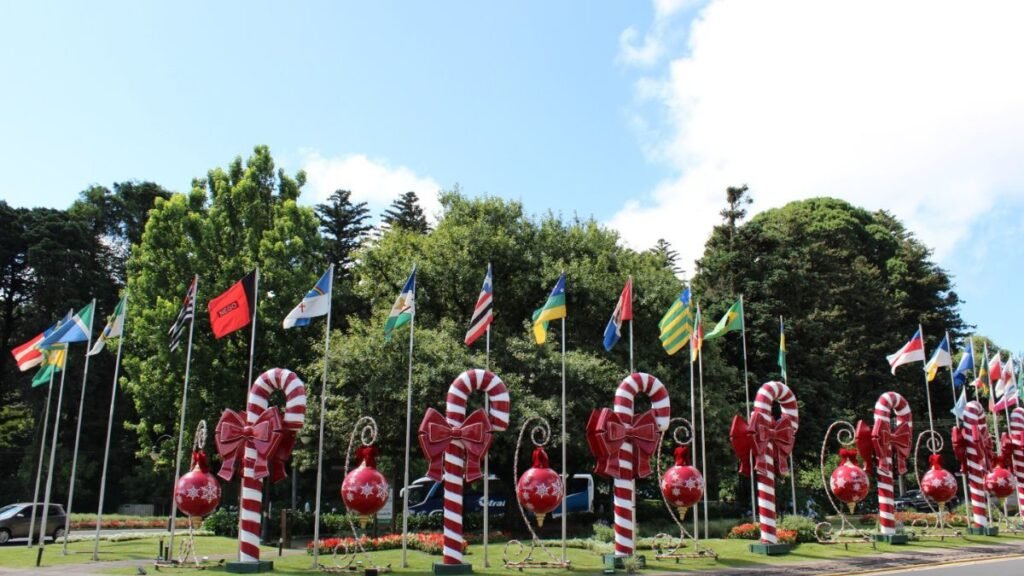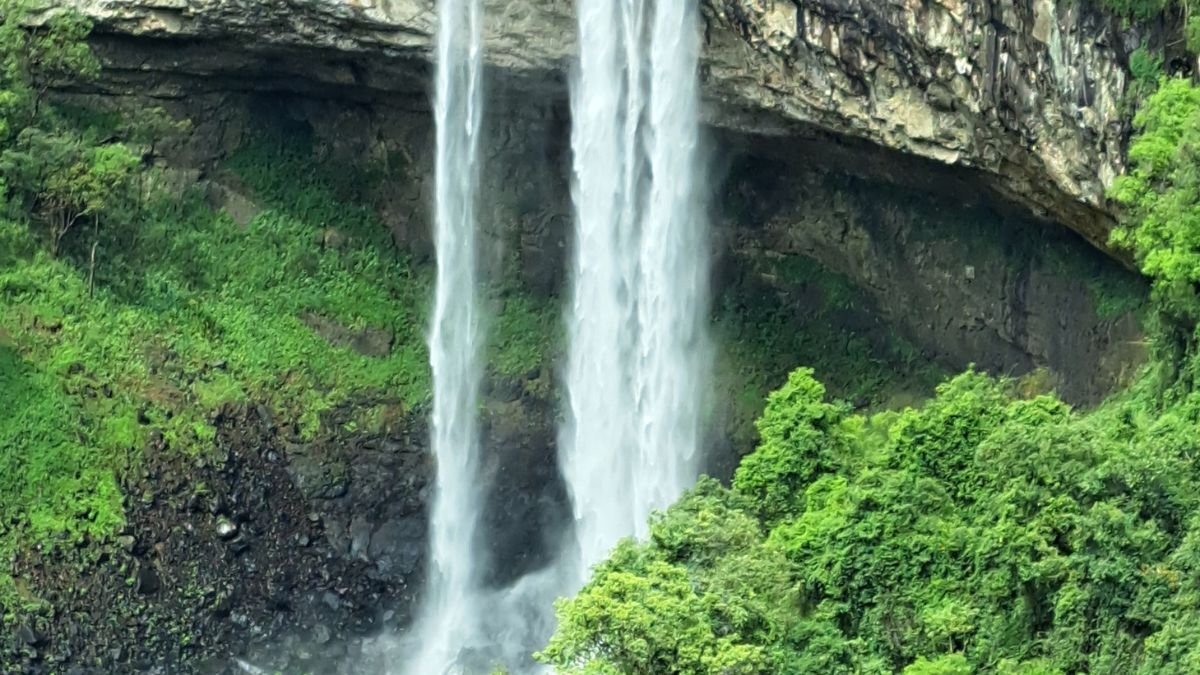Introduction
Have you ever wondered what a corner of Brazil could feel like, Europe without needing a passport? In the southern state of Rio Grande do Sul, five remarkable cities offer a unique Brazil Europe experience, where the warmth of Brazilian culture meets the charm of Italian and German heritage in a truly unforgettable blend.
Have you ever wondered how a corner of Brazil could evoke the charm of Europe without a single passport stamp? In Rio Grande do Sul, five European-inspired cities uniquely blend Brazilian warmth with rich Italian and German heritage.
These travel destinations offer picturesque architecture, vibrant festivals, and culinary delights that will transport you straight to the Old World. In this article, we will explore the enchanting cities of Gramado, Antônio Prado, Caxias do Sul, Bento Gonçalves, and Canela, each reflecting the profound influence of their European roots.

Key Takeaways
- Explore how European influences have shaped the culture in Rio Grande do Sul.
- Explore the picturesque charm of Gramado and its festivals.
- Experience the culinary heritage in Antônio Prado and Caxias do Sul.
- Savor world-class wines in Bento Gonçalves, Brazil’s wine capital.
- Visit Canela for its breathtaking natural attractions and eco-tourism.
Introduction to Brazil Europe
The concept of Brazil Europe encapsulates the unique blend of European cultural heritage found in the southern state of Rio Grande do Sul. This region has long been a melting pot of various European influences, prominently showcased in its architecture, culinary delights, and local traditions. Travelers seeking memorable experiences will find an array of sights and sounds that reflect the rich histories brought by Italian, German, and other immigrant communities.
In Rio Grande do Sul, tourism thrives not only on natural beauty but also on its vibrant cultural tapestry. Visitors flock to charming towns that evoke a distinctly European atmosphere, offering a range of experiences from pasta festivals to traditional German Oktoberfest celebrations. The combination of old-world charm and modern hospitality creates an inviting environment for tourists wishing to immerse themselves in the local culture.
As we delve deeper into specific cities throughout this article, the true essence of Brazil Europe will come to life. Each destination serves as a testament to the enduring legacy of immigrant cultures and their profound impact on contemporary Brazilian society.
Rio Grande do Sul: A Blend of Cultures
Rio Grande do Sul boasts a rich tapestry woven from an extensive immigration history, particularly through the influx of German and Italian immigrants in the 19th century. This migration has significantly shaped the region, resulting in a complex cultural diversity that defines local traditions, languages, and festivals. The state became a melting pot where European influences merged with indigenous cultures, establishing a unique identity that is notable in various aspects of life.
Historical Overview of Immigration
The historical journey of immigration in Rio Grande do Sul began in earnest during the mid-1800s when thousands sought new opportunities in Brazil. Settlement patterns reveal meaningful contributions from these communities, alongside critical events such as the Ragamuffin War, which underscore the vibrant yet tumultuous backdrop of this transformative era. Understanding these dynamics provides insight into how immigration has shaped the contemporary landscape of the region.
Influences of Italian and German Heritage
The Italian and German heritage in Rio Grande do Sul is profoundly ingrained in the cultural fabric of the region. Traditional customs, vibrant cuisine, and dialects from these communities persist, influencing everyday life. Celebrated events like Oktoberfest in Santa Cruz do Sul exhibit how these legacies continue to thrive, offering a glimpse into the interwoven narratives that characterize the area. Festivals draw locals and tourists alike, showcasing the enduring spirit of the immigrants who profoundly shaped the state’s identity.
Gramado: The Alpine Jewel of Brazil
Gramado serves as a magnificent destination showcasing beautiful and distinctive architecture alongside breathtaking scenic views. Known for its charming alpine-style buildings reminiscent of European ski towns, the city’s architecture stands out with its wooden structures and colorful facades. Nestled in the lush mountains of Rio Grande do Sul, Gramado boasts a rich natural landscape that enhances its beauty and draws visitors year-round.
Picturesque Architecture and Scenic Beauty
The preserved buildings in Gramado invite travelers to wander through its streets, where every corner unveils unparalleled designs and stunning views. Tall fir trees and vibrant flower gardens enrich the city, creating a harmonious blend with the architectural charm. The unique climate, characterized by cooler temperatures and occasional snowfall, adds a touch of magic to this alpine gem. Whether exploring its quaint shops or taking in the serene mountain vistas, visitors are continually rewarded with picturesque scenes.
Festivals and Events Throughout the Year
Throughout the year, Gramado hosts a range of exhilarating festivals and cultural events that celebrate its vibrant community spirit. The renowned Christmas festival transforms the city into a winter wonderland filled with enchanting decorations and lively parades. Other events highlight local traditions, showcasing the region’s music, food, and art. This vibrant atmosphere invites everyone to experience the essence of Gramado while engaging with its rich cultural heritage.
Antônio Prado: The Most Italian City in Brazil
Antônio Prado stands out as a vibrant testament to Italian culture in Brazil. This charming town captivates visitors with its unique architecture, reflecting the heritage of the Italian settlers who shaped its identity. The blend of historical buildings and the distinct Talian dialect spoken by its residents creates a rich cultural tapestry, inviting exploration of this captivating destination.
Discovering the Unique Heritage
Walking through the streets of Antônio Prado offers a glimpse into its past. The architecture features influences from northern Italy, showcasing beautifully preserved homes that embody a sense of pride among the community. Cultural traditions have been passed down through generations, keeping the Italian spirit alive. Events like local festivals highlight this heritage, allowing visitors to engage directly with the customs that define the city’s character.
Local Cuisine and Culinary Experiences
Antônio Prado boasts an array of culinary experiences that reflect its Italian roots. Traditional dishes, such as pasta and polenta, are staples in local restaurants, celebrating the blend of flavors that characterize Italian cuisine. Food festivals throughout the year offer an opportunity to savor these delights in a festive atmosphere, where the community comes together to celebrate its heritage. Notable restaurants offer menus that entice food lovers to indulge in authentic Italian flavors.
| Dish | Description | Typical Ingredients |
|---|---|---|
| Fritada | Pasta served with a rich meat sauce embodies classic Italian flavors. | Pork, spices, potatoes |
| Polenta | A creamy corn-based dish, often served as a side or base for meats. | Corn flour, water, cheese |
| Pasta al Sugo | Pasta, ground meat, and tomatoes | Pasta, ground meat, tomatoes |
Caxias do Sul: A Hub of Italian Culture
Caxias do Sul stands as a testament to the rich Italian heritage that permeates the region. Known for its vibrant culture and picturesque landscapes, this city is particularly famous for its exceptional Italian vineyards, where visitors embark on memorable wine tourism experiences. The area boasts numerous wineries, each offering unique insights into the intricate processes of winemaking.
Exploring the Rich Vineyards
The Italian vineyards in Caxias do Sul produce high-quality wines that reflect the traditions brought over by early immigrants. Visitors can engage in wine tours, gaining firsthand knowledge about grape cultivation and vinification techniques. These tours often culminate in tastings, allowing guests to savor the region’s distinctive wines. Some notable wineries to explore include Miolo Wine Group and Vinícola Salton, both of which offer compelling experiences for wine enthusiasts.
Festivals Celebrating Italian Heritage
The city’s vibrant festivals highlight its Italian roots, with the Festa da Uva being a standout event. Celebrated annually, this grape festival showcases traditional music, dance, and local cuisine deeply embedded in Caxias do Sul’s cultural fabric. Festivities draw crowds from all over, fostering a sense of community while preserving the rich traditions of Italian heritage. Visitors are captivated by the colorful parades and authentic culinary offerings that make this festival an unforgettable experience.
Bento Gonçalves: The Wine Capital of Brazil
Bento Gonçalves stands as a testament to Brazil’s rich viticultural heritage. Known as the wine capital of Brazil, this city offers an authentic enotourism experience that attracts visitors from around the world. Guests can embark on guided tours through picturesque vineyards, allowing them to discover the fascinating processes behind local wine production. Whether a novice or an aficionado, those participating in wine tastings will appreciate the diverse flavors and unique grape varieties that make these wines special.
Enotourism and Wine Tastings
The enotourism scene in Bento Gonçalves is vibrant, featuring an array of wineries that showcase not only their exquisite wines but also the enchanting landscapes of the region. Visitors often find themselves exploring historical wine cellars and learning about the art of winemaking. Events focusing on wine tastings offer participants the chance to savor different blends and varietals, all while enjoying personalized experiences tailored to enhance their appreciation of local wines.
Italian Gastronomy in Bento Gonçalves
Italian gastronomy thrives in Bento Gonçalves, reflecting the city’s rich cultural heritage. Local restaurants serve traditional dishes that harmonize beautifully with regional wines, creating unforgettable dining experiences. From homemade pasta to rich meats, the flavors of Italy come alive through careful preparation and attention to culinary detail. Pairing these dishes with the local wines elevates the meal, highlighting the harmonious relationship between food and drink.
Canela: Nature and European Character
Canela, a picturesque town in Brazil, offers a captivating mix of natural beauty and European charm. Known for its stunning landscapes, Canela is a hub for eco-tourism, making it a prime destination for adventure seekers and nature enthusiasts alike. The town features an array of natural attractions that not only showcase its scenic environment but also promote sustainability and conservation.
Natural Attractions and Eco-tourism
Visitors to Canela can explore breathtaking spots, such as Cascata do Caracol, a majestic waterfall surrounded by lush forests. Outdoor activities in Canela include hiking, birdwatching, and exploring its vast ecological parks. These natural attractions showcase the town’s dedication to preserving its environment while offering unforgettable experiences for travelers. Local eco-tourism initiatives focus on educating visitors about the region’s biodiversity, fostering a deeper appreciation for its natural wonders.
Festive Atmosphere Year-Round
Canela’s vibrant cultural scene keeps the festive spirit alive throughout the year. The town hosts a variety of events that celebrate its unique blend of nature and European heritage. Popular events include music festivals, craft fairs, and cultural gatherings that draw both locals and tourists. These festivities not only enrich the community but also serve as a platform for showcasing Canela’s rich traditions and diverse influences.
“Canela embodies the essence of eco-tourism, seamlessly integrating its stunning natural attractions with a rich cultural heritage.”
Santa Cruz do Sul: Celebrating German Traditions
Santa Cruz do Sul stands as a vibrant representation of German traditions, skillfully woven into the community’s fabric. This city takes immense pride in its heritage, prominently showcased through its annual Oktoberfest celebration. Visitors flock to this festival, drawn by its lively atmosphere, traditional German cuisine, and exceptional local brews that reflect the rich cultural tapestry.
Understanding Oktoberfest in Brazil
The Oktoberfest in Santa Cruz do Sul captures the essence of German culture with a Brazilian twist. This lively event features a diverse array of activities that celebrate the distinctive aspects of German heritage. Attendees can expect to experience a range of entertainment, from traditional music and folk dancing to a variety of culinary delights, including bratwurst and pretzels, paired with local craft beers. The festival not only celebrates local brewing techniques but also creates a communal spirit, inviting people from all walks of life to partake in the festivities.
Cultural Events Reflecting German Heritage
The cultural events in Santa Cruz do Sul extend well beyond Oktoberfest. The city hosts numerous festivals and gatherings that highlight its German roots. These celebrations include:
- Traditional folk music performances bring the community together.
- Dance events where locals showcase German folklore.
- Culinary fairs promoting authentic German dishes and beverages.
Such events foster a strong sense of community while inviting guests to explore and appreciate the vibrant history of Santa Cruz do Sul. Embracing these German traditions enables the city to maintain its unique identity while offering a warm welcome to visitors eager to explore its rich cultural heritage.

Why Rio Grande do Sul is a Must-Visit
Rio Grande do Sul, with its vibrant Gaúcho culture, stands out as an essential travel destination. Visitors are drawn to the warmth of the local hospitality, creating an inviting atmosphere that encourages genuine interactions. Engaging with residents offers insights into the traditions and communal spirit that characterize life in this remarkable region.
The Warmth of Gaúcho Culture
The essence of Gaúcho culture is evident in the friendly demeanor of the locals. This hospitality reflects a long-standing tradition where visitors are treated as family. The cultural practices, from music to dance, create a sense of belonging, making every traveler feel at home.
Unique Culinary Delights of the Region
The culinary scene in Rio Grande do Sul offers a tantalizing mix of flavors that define its rich heritage. Traditional dishes, such as the famous Churrasco, showcase the region’s penchant for grilling and barbecuing meats. Local ingredients combined with culinary expertise result in a dining experience that delights the senses, making it a true representation of the culture’s gastronomic delights.
Travel Tips for Visiting European-inspired Cities
Traveling to the European-inspired cities in Rio Grande do Sul offers a unique blend of culture and history. Effective transportation options can significantly enhance the journey, allowing visitors to explore fully. Planning is essential for maximizing your experience in this beautiful region.
Getting Around in Rio Grande do Sul
Various transportation options exist to navigate Rio Grande do Sul efficiently. Visitors can consider the following:
- Buses provide an affordable way to travel between cities and attractions. Look for schedules at local terminals.
- Guided tours offer convenience and local insights. Many companies specialize in cultural and historical tours.
- Car rentals allow for ultimate flexibility. Driving gives travelers the freedom to explore remote areas and enjoy scenic routes.
Best Times to Visit
The climate in Rio Grande do Sul varies throughout the year, influencing the travel experience. Consider visiting during:
- Spring (September to November), when flowers bloom, and pleasant weather make outdoor activities ideal.
- Autumn (March to May) for the beautiful fall colors and moderate temperatures.
- Winter (June to August) to experience unique winter festivals, particularly in the mountainous areas.
Local Cuisine: A Taste of Brazil Europe
The culinary scene in Rio Grande do Sul offers an exceptional glimpse into Brazil’s rich heritage. Central to this experience is the barbecue culture, where the art of preparing and enjoying grilled meats carries deep cultural significance. Churrasco stands out as the hallmark of local gatherings, embodying a communal spirit that brings friends and families together around the grill. This traditional Brazilian cuisine showcases not just flavors but a way of life, marked by an array of meats expertly seasoned and cooked to perfection.
Barbecue Culture and Churrasco
Churrasco is far more than just a meal; it is an important ritual in Brazilian barbecue culture. Various types of meat, including beef, pork, and chicken, are skewered and cooked over an open flame, allowing for smoky flavors to permeate each bite. As strangers and friends converge at a churrasco, lively conversations and heartfelt laughter fill the air, creating an unforgettable atmosphere. Ingredients such as chimichurri sauce and farofa, a toasted cassava flour mixture, generally accompany the grilled meats, enhancing the overall dining experience.
Popular Dishes to Try
While indulging in barbecue culture, explore other beloved dishes that define Brazilian cuisine in the region. Expect to find:
- Charque: This traditional cured meat, often served with rice and beans, boasts a robust flavor that reflects the region’s culinary heritage.
- Arroz Carreteiro: A hearty dish made with rice, meat, and spices, originally created by Brazilian gauchos, it reflects the agricultural lifestyle of the area.
- Galeto: Grilled young chicken that infuses local flavors with a tender, juicy profile, often served with traditional sides.
Each of these dishes tells a story of the local culture, offering visitors a genuine taste of Brazil Europe. The deep connections between food, community, and tradition remain evident through every meal shared in this vibrant region.
Events and Festivals to Experience
Rio Grande do Sul is renowned for its vibrant events and festivals that reflect the rich local traditions of the region. Each celebration offers a unique opportunity to immerse oneself in the diverse culture and history that shapes the identity of the communities. Engaging with these festivals allows visitors to appreciate the art, music, and culinary delights that have been passed down through generations.
Understanding Local Traditions and Celebrations
Local traditions play a crucial role in preserving the cultural heritage of Rio Grande do Sul. Celebrations often incorporate elements from both Italian and German influences, showcasing the unique blend of customs that have evolved over time. Through music, dance, and traditional cuisine, festivals provide an engaging experience for participants, enabling them to experience the warmth and hospitality of the local people.
Annual Festivals that Highlight Culture
Key annual festivals bring communities together to honor their heritage and celebrate their achievements. Notable events include:
- Festa da Uva: A celebration of winemaking, featuring grape harvests and local culinary delights.
- Oktoberfest: A vibrant festival celebrating German culture with traditional food, music, and drinks.
- Festa do Pêssego: A peach festival that showcases regional fruits and agricultural traditions.

These lively festivals showcase the region’s creativity and artistry, with local artisans displaying their crafts, musicians performing traditional songs, and attendees savoring delicious regional dishes. Whether through local traditions or exciting events, Rio Grande do Sul offers unforgettable experiences that reflect its rich cultural tapestry.
Accommodations: Staying in Style in Brazil Europe
Traveling through the European-inspired cities of Rio Grande do Sul offers a wide array of charming accommodations, from quaint hotels to inviting inns. These lodging options reflect the local architecture and hospitality, enhancing the overall travel experience with their distinctive character. Visitors can enjoy the blend of modern amenities and traditional design that makes for a comfortable stay in this vibrant region.
Charming Hotels and Inns
The area is home to numerous hotels and inns that showcase not only comfort but also cultural richness. Many of these establishments feature architectural styles reminiscent of European origins. For instance, some hotels offer luxurious accommodations complete with stunning views and premium services. Pousadas, or guesthouses, often provide an intimate setting with personalized service that embodies local traditions. Whether staying in a bustling hotel or a cozy inn, travelers can expect a warm welcome and an immersive experience.
Budget Options vs. Luxury Stays
Budget accommodations abound for those seeking economical options without sacrificing comfort. Affordable hotels and guesthouses allow visitors to explore the region’s beauty without a significant financial burden. At the other end of the spectrum, luxury stays are available in high-end hotels and upscale pousadas, offering amenities such as spa services, gourmet dining, and exquisite decor. Those planning their visit can consult this guide for a comprehensive overview of accommodations that cater to all preferences and budgets.
How to Get There and Getting Around
Visiting Rio Grande do Sul offers a remarkable experience enriched by its European-inspired cities. Understanding the transportation options can make your journey seamless. Here are several ways to reach this captivating region and get around once you arrive.
Transportation Options Available
The primary gateway to Rio Grande do Sul is the Salgado Filho International Airport, located in Porto Alegre. Flights from major cities in Brazil and the United States frequently connect here. For those considering overland travel, bus services operate extensively, linking Porto Alegre with other key cities in the state, including Gramado, Bento Gonçalves, and Caxias do Sul. Travelers seeking flexibility may opt for car rentals, allowing them to explore the scenic routes that this beautiful region has to offer.
| Transportation Option | Details | Average Duration |
|---|---|---|
| Flight | Salgado Filho International Airport – Direct connections from major cities. | Varies based on origin |
| Bus | Regular services from Porto Alegre to major destinations. | 1.5 to 3 hours, depending on the destination |
| Car Rental | Flexible travel options for personalized itineraries. | Varies by route |
Driving Tips and Road Conditions
For those who choose to drive in Rio Grande do Sul, being informed about road conditions is essential. Highways in the region are generally well-maintained, making for a smooth journey. It is advisable to exercise caution during rainy seasons, when roads may become slippery. Adhering to local driving laws, including speed limits and seatbelt requirements, ensures a safe experience on the road. Familiarizing yourself with traffic signs and signals will enhance your confidence while driving.
What Makes These Cities Unique?
The cities highlighted in this article showcase a rich tapestry of architectural styles influenced by European heritage. Each city tells a story through its buildings, reflecting design elements rooted in the aesthetics of Italy and Germany. This blend of European influence creates a distinctive character, with charming façades and intricate details found throughout the urban landscapes.
Architectural Styles Reflecting European Influence
The architectural styles in Gramado, Caxias do Sul, and beyond reveal an impressive lineage that speaks volumes of their European roots. Visitors can admire the timber and stone structures reminiscent of alpine villages or savor the ornate baroque designs echoing the grandeur found in European cities. These architectural choices not only enhance the visual appeal but also serve as a nostalgic reminder of the immigrants who shaped these communities.
The Blend of Nature and Culture
Nature thrives in tandem with cultural richness in these cities, creating an ideal setting for exploration. Lush landscapes surround the urban areas, offering stunning backdrops to historical landmarks. Parks and gardens, designed in harmony with the local environment, invite visitors to engage with nature while uncovering the stories of cultural heritage. This amalgamation enhances the overall experience, making a visit to these cities a memorable journey through time.
Conclusion
In summary, exploring the European-inspired cities in Rio Grande do Sul offers an incredible opportunity to experience a rich tapestry of culture, history, and cuisine. Each city presents its own unique story, shaped by the waves of Italian and German immigration that have left an indelible mark on the region. This travel summary highlights how destinations like Gramado, Antônio Prado, and Caxias do Sul not only showcase picturesque architecture but also flaunt vibrant festivals that celebrate their heritage.
Traveling through these enchanting cities in Brazil Europe allows visitors to indulge in local traditions, savor authentic culinary delights, and engage with warm and welcoming communities. From delightful wine tastings in Bento Gonçalves to the lively atmosphere of Santa Cruz do Sul’s Oktoberfest, every moment spent here fosters a deeper appreciation for the cultural diversity that defines this remarkable corner of Brazil.
As you plan your next adventure, consider Rio Grande do Sul for a travel experience that seamlessly combines the charm of European influences with the distinctiveness of Brazilian culture. Uncover the joys of this unique region, and let it inspire you to create unforgettable memories. Learn more Paraná.
FAQ
What are some cities in Rio Grande do Sul that exhibit European influences?
The cities that reflect European influences, particularly from Italian and German origins, are Gramado, Antônio Prado, Caxias do Sul, Bento Gonçalves, and Canela.
Why is Gramado considered a popular tourist destination?
Gramado is renowned for its alpine-style architecture, stunning natural landscapes, and various festivals throughout the year, including a famous Christmas festival that transforms the city into a winter wonderland.
What can visitors expect to experience in Antônio Prado?
Visitors to Antônio Prado can explore its unique architecture influenced by Italian settlers, enjoy local Italian cuisine, and experience cultural traditions, including the Talian dialect spoken by residents.
What highlights Caxias do Sul’s Italian culture?
Caxias do Sul is notable for its wine production and hosts numerous Italian heritage festivals, such as the Festa da Uva, which celebrates local music, dance, and culinary offerings.
What makes Bento Gonçalves a key destination for wine tourism?
Known as the wine capital of Brazil, Bento Gonçalves offers immersive enotourism experiences, including wine tours and tastings at its numerous vineyards that showcase unique grape varieties.
Can you tell me about Canela’s natural attractions?
Canela is celebrated for its breathtaking natural landscapes, including the Cascata do Caracol, and offers a range of outdoor adventures and eco-tourism activities, making it a haven for nature lovers.
What is the significance of Oktoberfest in Santa Cruz do Sul?
Oktoberfest in Santa Cruz do Sul is a major celebration of German traditions, featuring local brewing, culinary traditions, and a host of activities that attract visitors from across Brazil and beyond.
How does the Gaúcho culture enhance the travel experience in Rio Grande do Sul?
The welcoming nature of Gaúcho culture, characterized by unique traditions, hospitality, and community spirit, offers visitors authentic interactions and a meaningful cultural experience.
What are the best times to visit Rio Grande do Sul?
The best times to visit Rio Grande do Sul are those that consider the weather and local events, particularly around peak festival seasons, which enhance the overall cultural experience for travelers.
What culinary delights should I try when visiting Rio Grande do Sul?
While in Rio Grande do Sul, visitors should indulge in traditional dishes such as Churrasco, Charque, arroz carreteiro, and Galeto, which reflect the region’s rich cultural heritage.
What types of accommodations are available in the European-inspired cities?
Travelers can find a variety of accommodations, including charming hotels, inns, and guesthouses that reflect the local architecture, with options ranging from budget-friendly to luxury stays.
What transportation options are available to reach Rio Grande do Sul?
Visitors can access Rio Grande do Sul through flights, bus routes, or by driving, with helpful tips and information on road conditions provided to ensure a smooth travel experience.




